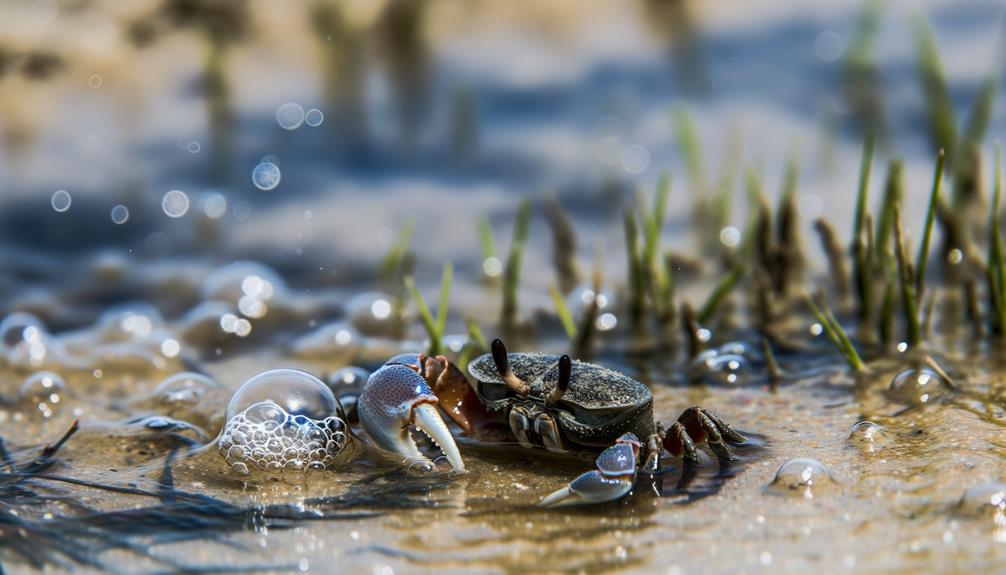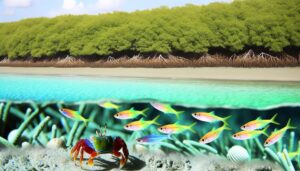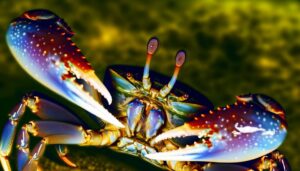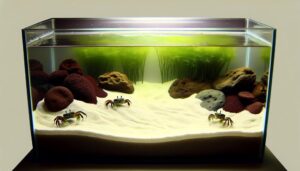How Do Fiddler Crabs Need Brackish Water at Home?
Fiddler crabs necessitate access to air due to their dual respiratory system, comprising gills for aquatic respiration and branchiostegal lungs for aerial oxygen uptake. This bimodal system allows efficient gas exchange via hemolymph, even in low oxygen conditions.
Their burrowing behavior mitigates desiccation and provides thermoregulatory benefits. Adapted to intertidal zones, fiddler crabs can tolerate air exposure for several hours without significant physiological stress.
These specialized respiratory adaptations enable their survival in fluctuating environments, showcasing evolutionary success in maintaining ionic balance and efficient respiration. To uncover more about their fascinating adaptations and ecological roles, continue exploring.

Key Takeaways
- Fiddler crabs can breathe both air and water using specialized gills and branchiostegal lungs.
- They can tolerate air exposure for several hours without significant physiological stress.
- Fiddler crabs have adapted to intertidal zones, which require periodic air breathing.
- Their burrowing behavior helps maintain moisture and facilitate aerial respiration.
- Evolutionary adaptations allow them to thrive in environments with fluctuating oxygen availability.
Fiddler Crab Anatomy
Fiddler crabs (Genus: Uca) exhibit a highly specialized anatomy, characterized by sexual dimorphism, with males possessing an oversized chela, which plays a vital role in their behavior and ecological interactions.
The male's enlarged chela, sometimes representing up to 40% of their body mass, is utilized in both combat and courtship displays, signaling fitness to potential mates. Females, by contrast, have two smaller, symmetrical chelae optimized for efficient feeding.
The carapace of fiddler crabs, covering the cephalothorax, provides structural support and protection. Additionally, their compound eyes on elevated stalks afford a wide field of vision, important for predator detection and social interactions.
Their locomotion is facilitated by jointed appendages, enabling rapid lateral movement essential for escaping threats and maneuvering their intertidal habitats.
Gills and Breathing
The respiratory system of fiddler crabs is adapted for both aquatic and terrestrial environments, utilizing gills that facilitate efficient gas exchange. These gills, located within branchial chambers, are highly vascularized, allowing for best oxygen uptake from water.
The gills function via a countercurrent exchange mechanism, maximizing the gradient for oxygen diffusion. Hemolymph, analogous to blood in vertebrates, transports oxygen throughout the crab's body.
Data indicate that fiddler crabs can maintain aerobic respiration in water with oxygen concentrations as low as 2 mg/L. Moreover, specialized osmoregulatory structures within the gills help in maintaining ionic balance.
This dual capability underscores the evolutionary adaptability of fiddler crabs, ensuring survival in fluctuating environmental conditions prevalent in intertidal zones.
Terrestrial Adaptations
Fiddler crabs exhibit significant terrestrial adaptations, notably through their burrowing behavior which helps maintain moisture levels critical for their gill function.
These burrows serve as microhabitats, mitigating desiccation and providing a controlled environment for gas exchange.
In addition, their respiratory system has evolved to utilize both aquatic and aerial oxygen, demonstrating a dual capability that is essential for surviving in intertidal zones.
Burrowing for Moisture
To lessen desiccation in their terrestrial habitats, fiddler crabs engage in burrowing behaviors that maintain access to necessary moisture levels. These burrows provide a microenvironment with stable humidity and temperature conditions conducive to their survival.
Key aspects of this behavior include:
- Depth Regulation: Crabs dig burrows to specific depths, often reaching groundwater to guarantee consistent moisture.
- Burrow Architecture: The shape and orientation of burrows optimize humidity retention and minimize water loss.
- Behavioral Thermoregulation: By retreating into burrows during peak heat, fiddler crabs avoid excessive dehydration.
- Salinity Management: Burrows in intertidal zones help control salinity levels, essential for osmoregulation.
These adaptive strategies highlight the crabs' complex responses to their environment, ensuring their physiological needs are met efficiently.
Respiratory System Adaptations
Adapting to terrestrial life, fiddler crabs exhibit specialized respiratory systems that enable efficient gas exchange in both aquatic and air environments. Their gills, typically used for aquatic respiration, are complemented by a branchiostegal lung, an adaptation allowing aerial respiration.
Research indicates that the vascularization within these structures enhances oxygen absorption efficiency. According to studies, fiddler crabs can survive extended periods out of water, with some species enduring up to 48 hours in air, showcasing exceptional respiratory versatility.
Additionally, the presence of setae on their gill chambers aids in maintaining moisture, essential for gas diffusion. This dual respiratory mechanism not only underscores their adaptability but also their evolutionary success in intertidal zones where fluctuating environmental conditions demand physiological resilience.
Role of Water
The role of water in the physiological processes of fiddler crabs is multifaceted. It influences oxygen exchange mechanisms, salinity tolerance, and thermoregulation.
Oxygen exchange in water is facilitated by the crabs' gills, which are adapted to efficiently extract dissolved oxygen, a critical factor for survival in intertidal zones.
Additionally, the salinity of their habitat determines species distribution, while water temperature impacts metabolic rates and overall fitness.
Oxygen Exchange in Water
Water acts as a medium for oxygen exchange in fiddler crabs, facilitating the diffusion of dissolved oxygen across the gill membranes. This process is crucial for their respiratory efficiency and overall metabolic function.
The role of water in oxygen exchange can be understood through several key aspects:
- Dissolved Oxygen Concentration: Levels of dissolved oxygen in water vary with temperature, salinity, and pressure, directly impacting the oxygen availability for fiddler crabs.
- Gill Surface Area: The morphology of gills, including surface area and structure, is adapted to maximize oxygen uptake from water.
- Ventilation Mechanisms: Fiddler crabs employ rhythmic movements to enhance water flow over their gills, optimizing oxygen diffusion.
- Oxygen Diffusion Rate: The efficiency of oxygen diffusion from water to blood depends on the gradient of oxygen partial pressures between the environment and the crab's internal systems.
Salinity and Habitat Preference
Considering the intricate mechanisms of oxygen exchange in fiddler crabs, salinity levels significantly influence their habitat preference by affecting their osmoregulatory processes and overall physiological stability. Fiddler crabs exhibit a strong preference for intertidal zones where salinity fluctuates, enabling them to regulate ionic and osmotic balance effectively. Studies indicate that these crabs thrive in salinity ranges from 15 to 30 parts per thousand (ppt), enhancing metabolic efficiency and respiratory function.
| Salinity (ppt) | Preferred Habitat | Physiological Impact |
|---|---|---|
| 0-10 | Freshwater | Osmotic stress, reduced activity |
| 15-30 | Brackish/Intertidal | Optimal osmoregulation, high activity |
| 35+ | Marine | Hyperosmotic stress, energy drain |
This adaptability underscores the importance of salinity in the ecological niche and survival of fiddler crabs.
Water Temperature Effects
Exposure to varying water temperatures significantly impacts the physiological processes and survival rates of fiddler crabs. These ectothermic organisms rely on their ambient environment to regulate body temperature, influencing metabolic rate, immune function, and reproductive success. Empirical studies have identified best temperature ranges for different fiddler crab species, revealing significant deviations can lead to stress responses and mortality.
Key findings include:
- Thermal Tolerance: Fiddler crabs typically thrive in temperatures between 20°C and 30°C.
- Metabolic Rate: Elevated temperatures increase metabolic activity, hastening energy depletion.
- Reproductive Viability: Less than ideal temperatures can impair gametogenesis and larval development.
- Immune Response: Thermal stress may compromise immune defenses, heightening susceptibility to pathogens.
Understanding these temperature effects is important for conservation and habitat management efforts.
Air Exposure Tolerance
Fiddler crabs exhibit remarkable tolerance to air exposure, an adaptation facilitated by their specialized respiratory systems which include both gills and branchiostegal lungs. This dual respiratory mechanism allows them to efficiently extract oxygen from both water and air, enabling survival during tidal fluctuations. Studies indicate that fiddler crabs can sustain up to several hours of air exposure without significant physiological stress. The table below summarizes key parameters of their air exposure tolerance:
| Parameter | Value |
|---|---|
| Max Air Exposure | Up to several hours |
| Oxygen Uptake | Via gills and branchiostegal lungs |
| Physiological Stress | Minimal under short-term exposure |
| Habitat Adaptation | Intertidal zones |
This ability underscores their evolutionary success in highly variable intertidal environments.
Burrowing Behavior
Burrowing behavior in fiddler crabs is a complex activity driven by environmental factors such as tidal cycles, predation risk, and reproductive needs. These behaviors are essential for their survival and reproductive success. Research has identified several key aspects of their burrowing activities:
- Tidal Influence: Fiddler crabs synchronize their burrowing with tidal patterns, retreating into burrows during high tides to avoid submersion and predation.
- Thermoregulation: Burrows provide a stable microhabitat, helping crabs regulate their body temperature and mitigate extreme thermal conditions.
- Mating Sites: Male fiddler crabs construct specialized burrows to attract females for mating, enhancing reproductive opportunities.
- Predation Avoidance: Burrows offer a refuge from predators, reducing mortality rates among fiddler crab populations to a significant degree.
Understanding these behaviors elucidates the adaptive strategies of fiddler crabs in intertidal environments.
Comparing Aquatic Species
Given the intricate burrowing behaviors of fiddler crabs, it is valuable to compare these species with other aquatic organisms to understand the diversity of adaptive strategies in similar environments.
Fiddler crabs (Uca spp.) exhibit semi-terrestrial adaptations, utilizing specialized gills that enable both aerial and aquatic respiration. Conversely, species such as the blue crab (Callinectes sapidus) are mainly aquatic, relying on gills for dissolved oxygen extraction.
Mudskippers (Periophthalmus spp.), another comparison, demonstrate amphibious adaptations, employing cutaneous respiration and modified gill chambers to survive on land. These comparative analyses elucidate how different species have evolved distinct respiratory mechanisms to optimize survival, reflecting the intricate balance between environmental demands and physiological capabilities.
Understanding these variations highlights the ecological niche specialization among aquatic organisms.
Environmental Influence
The environmental conditions of intertidal zones dictate the physiological adaptations and behavioral strategies that fiddler crabs employ for survival. These crabs have evolved to thrive in habitats where fluctuations in water and oxygen levels are frequent.
The following points illustrate key aspects of their environmental influence:
- Oxygen Regulation: Fiddler crabs possess specialized gills and branchiostegal lungs, allowing efficient respiration in both aquatic and terrestrial environments.
- Burrow Construction: To mitigate temperature and humidity extremes, fiddler crabs construct burrows that provide stable microhabitats.
- Salinity Tolerance: These crabs exhibit osmoregulatory mechanisms that enable them to maintain cellular homeostasis in varying salinity conditions.
- Diurnal Activity: Fiddler crabs adjust their activity patterns to synchronize with tidal cycles, optimizing feeding and mating opportunities.
Human Impact on Habitats
Human activities, such as coastal development and pollution, have disrupted the delicate balance of intertidal ecosystems, posing substantial threats to fiddler crab populations. Urban expansion often results in habitat fragmentation, reducing the available space for these crabs to thrive. Additionally, pollutants like heavy metals and hydrocarbons infiltrate the sediment, compromising the crabs' ability to respire through their gills and burrows. Empirical studies have shown a decline in population density correlated with increased anthropogenic activities.
| Human Activity | Impact on Habitat | Consequence for Fiddler Crabs |
|---|---|---|
| Coastal Development | Habitat Fragmentation | Reduced Living Space |
| Industrial Pollution | Contaminated Sediments | Impaired Respiration |
| Overfishing | Disrupted Food Chains | Decreased Nutrient Availability |
| Climate Change | Rising Sea Levels | Loss of Intertidal Zones |
Mitigating these impacts requires stringent environmental regulations.
Conclusion
Fiddler crabs, with their uniquely adapted respiratory systems, exemplify evolutionary genius, thriving at the interface of land and sea. Boasting dual capabilities, their gills extract oxygen efficiently from both water and air, showcasing unparalleled adaptability.
Terrestrial adaptations, such as burrowing, further enhance their survival in fluctuating environments. This intricate balance, however, is gravely threatened by anthropogenic impacts, underscoring the urgency for conservation efforts.
The delicate symbiosis between these crabs and their habitats demands vigilant protection to prevent ecological disruption.






